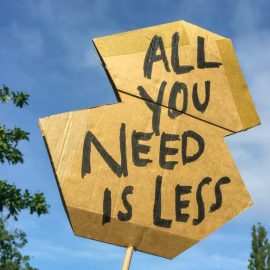

This article is an excerpt from the Shortform book guide to "Switch" by Chip and Dan Heath. Shortform has the world's best summaries and analyses of books you should be reading.
Like this article? Sign up for a free trial here .
How does visualizing goals make them more attainable? How can short-term guidelines also help you get there?
Goals are hard to reach when they are ambiguous. It helps to make objectives clear and measurable. A great way to do this is to visualize goals, basically painting a picture of your destination. This technique, along with short-term guidelines, puts real change within grasp.
Keep reading to learn about visualizing goals.
Achieve Change by Visualizing Goals
One problem that many people run into when making goals—both on a personal level and an organizational level—is that they focus on an ambitious, ambiguous result. These types of results don’t have a clear metric for measuring “success” and often take a long time to reveal themselves. When you can’t quantify or immediately see success, you quickly become discouraged. And, if your goal is too far off, you lose sight of what you’re working toward. Imagine you set the goal to “lose weight.” With an ambiguous goal like this, you don’t know exactly what you’re aiming for, which makes it hard to understand your progress.
Change is most successful when your goals have two essential elements:
- The desired result is a clearly visualized destination.
- This destination isn’t too far in the future.
For example, make your weight loss goal feel more achievable by setting a clear destination such as, “I want to fit into my favorite jeans again.” This tangible destination means that you know exactly what you’re aiming for. And, you can measure your success—every few weeks, you try on your jeans to see how much you’ve advanced toward your destination.
Become Solution-Focused by Visualizing Goals
Clear destinations are an essential counter to the over-analytical nature of your rational side. When your goals are too vague, you open up two avenues of overanalysis.
- You analyze your current situation in an attempt to decide if the problem that needs to be solved even exists.
- If you accept that a problem exists, you run through all the possible solutions to it.
On the other hand, visualizing goals by coming up with vivid destinations helps direct your rational energy away from the problem and toward the solution, in two ways:
1) It articulates why change is necessary and worth the effort. You don’t have to think about whether there’s a problem, because the problem is immediately clear.
- For example, the vague goal of losing weight might make you wonder if you’ve really gained enough to do something about it. On the other hand, your clear “favorite jeans” destination makes the problem obvious: You’ve gained enough to not fit in your pants.
2) It interrupts your tendency to get caught up in the thinking and planning phase and pushes you into the doing phase. Instead of mulling over the details of your current situation and the many ways you could move forward, your thinking shifts to specific ways you can work toward the destination.
- A vague weight loss goal would lead you to research your BMI and how much weight loss is enough for someone like you. On the other hand, your “favorite jeans” goal doesn’t need analysis—when you fit in your jeans, you’ve lost enough weight.
- Instead of researching hundreds of possible diets and workout routines, you think about your lifestyle when you last fit into your jeans (a success story, of sorts). You think, “I fit in those jeans while I was working at my old job that required a lot of walking. Walking more will be a good first step toward my goal.”
Beware of Rationalization When Visualizing Goals
Even with a clear destination in mind and a genuine desire to change, you can all too easily be pulled off course by your emotional desires. Your emotional side is incredibly strong—as soon as you let it take over as your decision-maker, your rational side starts coming up with rationalizations of your anti-change actions.
Imagine you started an exercise routine to reach your “favorite jeans” destination. After a few weeks on track, you decide to stay in bed for an extra hour and skip your morning walk. You rationalize the choice: “I’ve been on track so far. I deserve a day off. And I shouldn’t do too much exercise or I might injure myself.”
In rationalizing your anti-change actions, you destroy your change potential in two ways:
- Giving in to your emotional desires is a return to the easy status quo—the action moves you in the opposite direction of your change.
- Rationalization makes you think that you’re just taking a small, controlled step away from the path to your goal. You believe you’re still going in the right direction, driven by your rational side’s desires. These small steps build into a slow and steady backtrack—which you won’t notice until you’re back at square one.
Fight Rationalization: Blend Destinations and Guidelines
The best way to stay on track with your rational side’s desires and avoid emotional takeover is by blending short-term guidelines with your longer-term destination as you visualize goals.
The reason short-term guidelines and long-term destinations work so well together to create change is that successful change depends on having a strong beginning and a strong ending. What happens in the middle doesn’t matter as much—it usually looks nothing like you expect it will, and it usually sorts itself out as you successfully get the ball rolling with short-term change-supporting actions and have a vivid idea of where you’ll end up.
For example, you set your “favorite jeans” destination and create short-term guidelines that don’t leave any wiggle room for rationalization.
- Hit a minimum of 8,000 steps per day, except Sunday
- Absolutely no soda or beer
- Only one takeout order per week
Along the way, you might discover that you prefer to do Pilates twice a week instead of walking, you tend to overindulge in wine but have control with low-cal beer, and ordering sushi a few times a week is healthier than the meals you cook up on busy nights. You change your guidelines accordingly. The strict starter guidelines did their job of getting you moving in the right direction, and your vivid destination ensures that your guideline tweaks keep you on the path.
By visualizing goals—and blending that clear, long-term destination with short-term guidelines—you are far more likely to make change that sticks.

———End of Preview———
Like what you just read? Read the rest of the world's best book summary and analysis of Chip and Dan Heath's "Switch" at Shortform .
Here's what you'll find in our full Switch summary :
- Why some changes succeed while others fail
- Actionable advice for creating changes that not only succeed but stick
- The three essential elements for successful change






